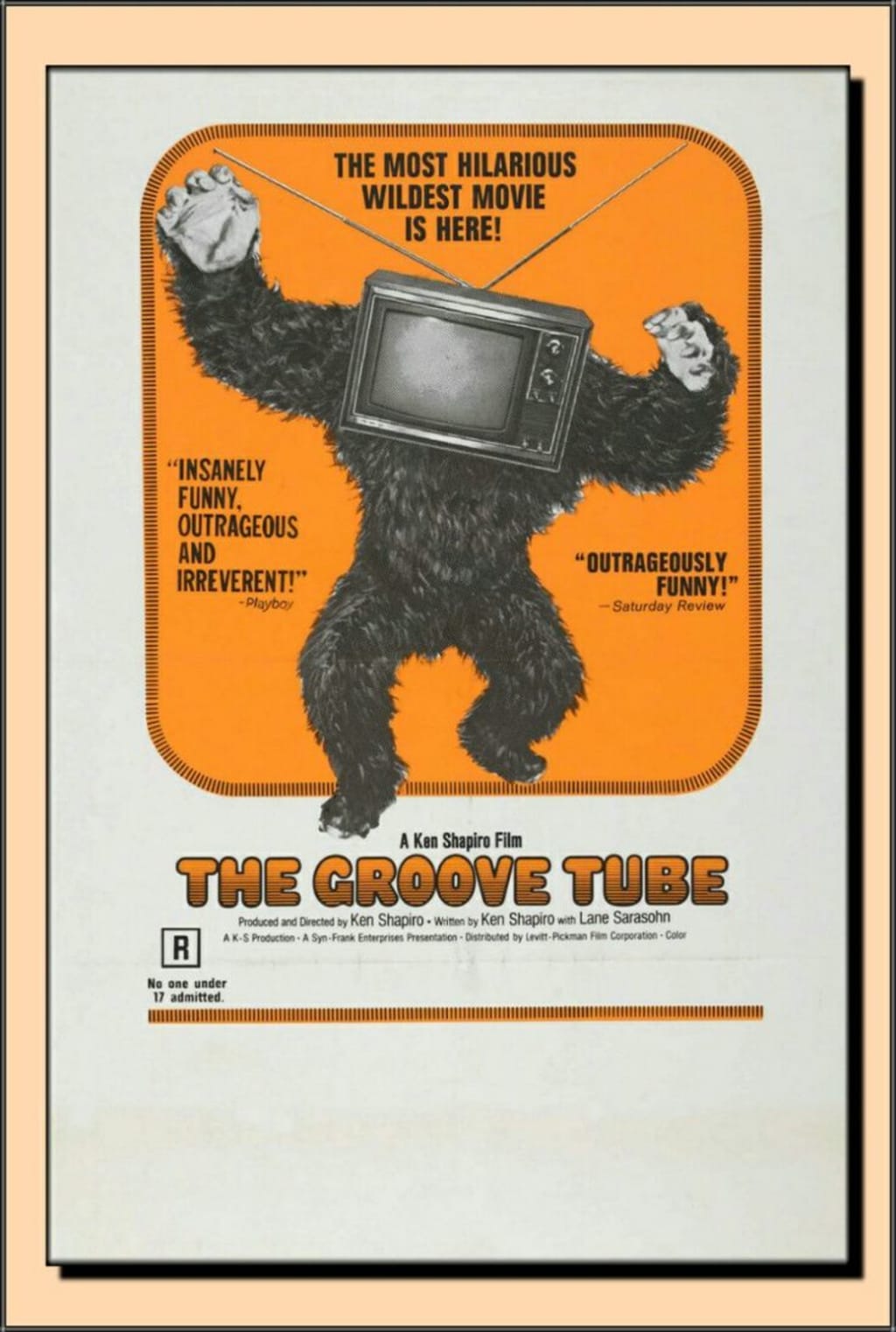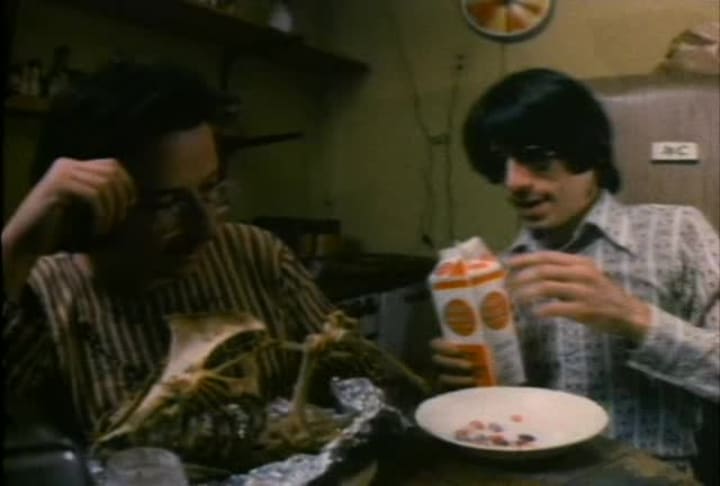
It's not often I watch comedies unless they're a hundred and five years old.
That said, ONE comedy, 1974's The Groove Tube, directed by the late Ken Shapiro and starring a very young Chevy Chase, as well as a young Richard Belzer, is a notable exception. I first saw the kinky, psychedelic thing on Cinemax in the 1980s, when I was a wee tot (staying up late to watch things I shouldn't have been watching, of course), and it gave me sort of a sick feeling in my gut; a lot of it was gross-out, potty humor. It came straight from that OTHER world that had existed just prior to my birth: a world of the late Sixties, early Seventies, a place of funk music, Black Power, psychedelic hippie activism, pot, pot, sexual liberation...and, well, pot. The Groove Tube seeks to lampoon these variant societal tendrils, all the while satirizing the homogenized, domesticated intellectual fluff and brain-programming being offered up at the time on a regular, average, thirteen-channel tube television.
It began, according to Wikipedia, that unimpeachable internet resource, as a series of experimental sketches at a New York theater (Channel One Theater on East 60th St.) that used the gimmick of projecting said sketches on multiple TV sets. (One wonders: were these large or oversized television sets?)
The material was compiled and toured around college campuses. The best-received sketches were then used in the film. Both the original sketches, as well as the film, starred many of the same actors; I'm assuming the soon-to-be famous Chevy Chase, too.
The film has an undeniably seedy, low-rent aesthetic. It starts off with a parody of 2001, the curiously humanoid ape people discovering, not a black monolith but, instead, an old tube television set. Touching it, they begin to shimmy and shake.
The opening credits hint at Seventies psychedelia, images of old-fashioned, archaic communication devices finally flowing, in multicolored, acid tripping wonder, into images of a "conventional American Family" sitting in front of the reliable old glass teat.
Suddenly, we break into "Move On Up" by Curtis Mayfield, a young, scraggly-headed, and not particularly good-looking young man in bell- bottom pants, hitchhiking out on the open road, when a young woman in a convertible stops to give him a lift. Soon, she's making the moves on him, leading him on a merry chase through the woods, slowly stripping off her clothes, revealing a delectable form.
The streaking nymphet is closely followed by the young man, who is, likewise stripping off HIS clothing, revealing full-frontal nudity. The denouement of this "love chase" is the young man finally emerging, fully naked, into a clearing, only to discover that he has not found his Juliet, but instead the waiting arms of a police officer, eager to throw a naked hippy into jail.
The skits come fast and reveal an entire era for all its corniness and hackneyed, trite consumerism and conventionalism. We're treated to parodies of toothpaste commercials; Barbie and Ken Dolls (Barbie and Ken end up in therapy, divorce court, all because Ken's cheating with his secretary. At the end of the sketch, it is revealed they each are smooth between the legs); "Geritan" (a commercial starring Chevy Chase and a then-popular erotic actress, which ends with her obviously performing oral sex on him, her legs sticking out of the bed covers next to his head); and a children's TV show starring a lovable clown (Ken Shapiro), who encourages the kids to "send their parents out of the room," while he lights up and calmly reads from Fanny Hill.
A political analysis show ends when the distribution of snack food seems to preoccupy the guests. A cooking show becomes an exercise in gross-out absurdism, as a literal brick is baked for a cake loaf. A commercial for "Brown Number 2," produced by the "Uranus Corporation" (emphasis on the second syllable of course), suggests human excrement. There are satirical news reports from war-torn Southeast Asian countries with obscenely suggestive names; behind the war correspondent, three soldiers out of a Three Stooges short set-up field artillery.
All of this is to mock the bourgeois sensibilities and crass commercialism of the era's television programming. If it does so itself, in a way that is crass or over-the-top, that is to be expected; the radical sense of humor it attempts to proffer is par for the course in an era when common, middle-class American values were being questioned or sloughed-off, brought about by the cynicism engendered by the shadow of Vietnam. American consumerism is, it suggests, phony, surface-shallow, and committed to something other than what it appears to be on the surface. It seems to be asserting that at the heart of the American Dream is corporate greed, stupidity, political and human corruption, and an absurd culture, obsessed, narcissistically, with its own image.
The Dealers
The centerpiece of The Groove Tube is undoubtedly the segment starring Shapiro and Richard Belzer ( "Boss" and "Rodriguez") as two bumbling drug dealers. It's a satirical "movie" called "The Dealers", with a funk soundtrack, and it sort-of predates Cheech and Chong.
In the segment, we're introduced to Shapiro and Belzer's characters in an airport, where they are bulging out of weird "fat men" suits, in which is revealed later they have sewn pounds of marijuana. Belzer comments on what a genius Shapiro is. Their misadventures include having a panic episode at the house of a rich white man in Seventies leisure attire, who seems to be a parody of William F. Buckley; getting followed by a cop and, in a scene that would be recreated by Cheech and Chong years later, eating fistfuls of marijuana in terror of being busted (in the Cheech and Chong version, it is cocaine and urine); and having sex in a Times Square movie theater while a silent film of a train is being shown.

A burglar, finally, breaks in and steals their stash of dope. Ken Shapiro has a psychedelic meltdown in which he imagines himself as a cartoon character (the animation is reminiscent of Ralph Bakshi's "rotoscope" technique) floating in a kaleidoscopic void, being chased by a giant dog, etc. He wakes up, complaining to Rodriguez loudly for their lack of money, food, success, and then begins to slyly suggest they go to bed together. The homophobic subtext wouldn't cut it today, but the punchline is that the film is a "public service announcement" from the National Council of Churches.
The remainder of the film features skits with scat-singing dubbed over a meeting of the Democratic National Convention, a public service announcement about VD delivered by a literal penis, and Ken Shapiro running through the streets of Manhattan, singing a corny lounge number to astounded passers-by, before plunging into a fountain. The End.
The Groove Tube will not cause anyone to bat an eyelash today of course; it is the precursor to the sort of Mad Magazine-level sketch comedy and parody proffered by The Kentucky Fried Movie and, of course, "Saturday Night Live," which both Shapiro and Belzer were involved with.
"Saturday Night Live," of course, became famous for challenging the staid conservatism of the Reagan era. The Groove Tube, by contrast, is the product of an era when cynicism at middle-class values was endemic among college-age young adults, growing up in the lengthening shadow cast by Vietnam.
For myself, the film also marks a particular period of youth, as I first acquired a copy from a Kmart store on videocassette, a cheap, poorly-produced copy from a company that, at the time, called themselves "Video Treasures." Their product was badly-reproduced editions of cult classic films, such as Texas Chainsaw Massacre and Night of the Living Dead. These were sold on budget racks and cut-out bins in down-at-the-heels shopping centers across America. But this somehow seems oddly perfect for a grungy, unsavory cinematic cultural relic like The Groove Tube.
About the Creator
Tom Baker
Author of Haunted Indianapolis, Indiana Ghost Folklore, Midwest Maniacs, Midwest UFOs and Beyond, Scary Urban Legends, 50 Famous Fables and Folk Tales, and Notorious Crimes of the Upper Midwest.: http://tombakerbooks.weebly.com






Comments
There are no comments for this story
Be the first to respond and start the conversation.